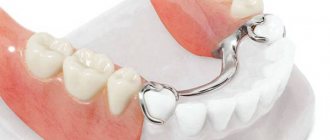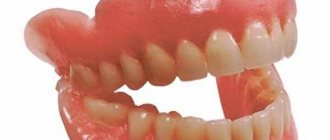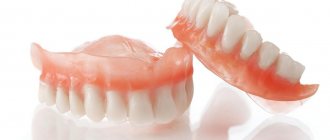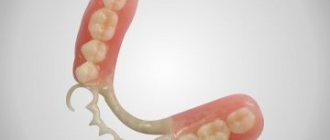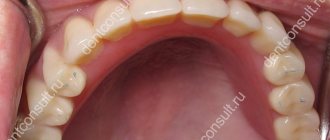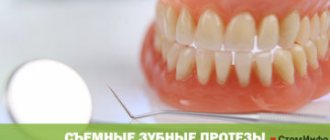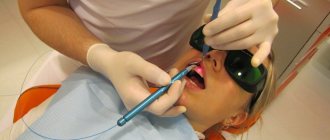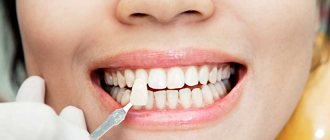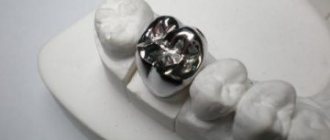Clasp dentures are one of the most advanced and cost-effective dentures that can restore partially lost teeth, either in the upper or lower dentition. Clasp dentures are, in fact, the most common dentures, consisting of a plastic gum base and dental crowns. In this case, all components of the prosthesis are attached to a metal arcuate arch. The metal frame allows you to securely fasten all the components. The prosthesis rests on the patient’s gums and natural teeth, clinging to them with metal hooks.
When are clasp dentures used?
• restoration of partially lost teeth (one or more teeth)
• dental defects: terminal, lateral, absence of front teeth
• a method of treating periodontal disease - a disease in which teeth become mobile. A clasp denture allows you to reliably fix loose teeth in place, as a result of which the ligaments holding the tooth in the socket become less elastic and the tooth ceases to be mobile
• can be used for pathological abrasion of teeth, as well as malocclusion
The main requirement is the presence of several supporting teeth to which the prosthesis will “cling.” This fastening allows you to evenly distribute the load on the teeth and bone tissue, and also securely secure the prosthesis in the oral cavity.
Types by method of fixation
Clasp dentures are removable dentures and differ in fixation methods:
• Clasp denture with clasps. Clasps are ordinary metal hooks that are located at the base of the supporting teeth. This fastening ensures reliable fixation of the prosthesis in the oral cavity, however, under heavy loads it can lead to minor damage to the tooth enamel.
• Clasp prosthesis with locks (attachments). Attachments are a more complex mount that consists of two parts. The first part of the lock is on the artificial tooth of the prosthesis, the second is on the patient’s tooth, which is covered with a crown on top. This fastening is considered reliable and, most importantly, aesthetic; it allows you to get used to the clasp prosthesis very quickly and does not cause any inconvenience.
• Clasp dentures on telescopic crowns. This type of prosthetics is considered one of the most expensive, since it requires jewelry and precision work from the dental technician. Telescopic crowns are a system consisting of two fastening elements: a cone-shaped base (usually a ground natural tooth or an installed dental crown) and a dental crown, which has an internal cavity exactly the same shape as the base. Thus, one part of the crown fits into the other, ensuring reliable fixation of the prosthesis.
Advantages
• availability of prostheses for many patients
• high aesthetic qualities
• the possibility of combining treatment and restoration of missing teeth
• prevention of gum disease, which leads to loosening and subsequent tooth loss
• no need to remove the clasp denture at night or while eating
• the prosthesis is easy to care for
Flaws
The main disadvantage of clasp dentures is the long period of getting used to them. Often, metal clasps or hooks can rub the gums in the first few days or weeks after installation and cause discomfort while eating. However, all problems are eliminated by adjusting the position of the hooks.
Necessary care
Before installing a removable clasp denture, the teeth on which it will rest are carefully prepared: they are filled, the enamel is restored, or the tooth is simply covered with a clasp crown. The denture is made from modern dental materials, so daily cleaning once or twice with a regular brush and rinsing under running water is all your partial denture needs. The lifespan of a clasp prosthesis is more than 10 years—every day, impeccable service.
Life time
The service life of clasp dentures is more than ten years with proper and careful care. It is recommended to rinse dentures with water after each meal and brush them twice a day with a toothbrush with special products - in this case they will last no less than the stated period.
Prices
The process of making clasp dentures is very labor-intensive, requiring a lot of time, maximum concentration and the use of precise, modern equipment and tools. The most important thing when making a clasp prosthesis is to create it in such a way that it suits the patient in shape and size after the first fitting and subsequently does not cause discomfort. The cost of clasp dentures depends on the complexity of the work and the amount of materials used
Orthopedic dentist, surgeon Roman Shotaevich Burduladze
Acrylic dentures on hooks
The cheapest, and therefore the most popular, denture with hooks is made of acrylic. It is an acrylic base (base) resting on the alveolar ridge, in which artificial dental crowns made from the same acrylic are fixed (ceramic dental crowns are less commonly used).
Acrylic plastic is a cheap and easy-to-process material, which explains the low cost of prosthetics. Thanks to a wide range of colors, the dental technician selects a shade of acrylic that is similar to the natural tissues of the oral cavity. Due to this, acceptable prosthetic aesthetics are achieved. However, acrylic plastic is not able to imitate the natural transparency of the mucous membrane, so the prosthesis will still be noticeable in the mouth.
Acrylic is a fairly dense and lightweight material; it does not deform during use, and after adaptation is completed, the design does not cause significant inconvenience to wear.
Types of clasp dentures with clasp fixation
According to the design and purpose of the structure, two types of prostheses are distinguished - conventional and splinting.
Conventional clasp dentures with clasps
They are recommended in cases where it is not possible to place implants and there are still teeth in the mouth that can be used as a support for a prosthesis. The design allows you to eliminate such dental defects as:
- absence of three or more teeth in a row (front, side, on one side of the jaw and/or on different ones);
- terminal defects of the dentition (when the last teeth are missing).
Splinting clasp dentures on hooks
They differ from ordinary ones in that in their design they have special retainers (processes on the arch) for supporting teeth. Used to restore dentition in patients suffering from:
- pathological mobility of teeth (the prosthesis fixes loose teeth and protects them from excessive chewing load);
- malocclusion (the design holds the teeth in the correct position, thereby correcting abnormal jaw closure);
- increased abrasion of the upper teeth (the prosthesis covers the chewing surface of worn-out teeth, making them higher and protecting them from further abrasion).
Depending on the materials, there are 2 types of clasp dentures:
- Prostheses containing metal. The arc and clasps (and sometimes the base frame) of such structures are made of chromium-cobalt or gold-platinum alloy.
- Metal-free structures. The so-called Quadrotti prostheses (Quattro Ti) with nylon clasps and a base made of a mixture of nylon and hypoallergenic plastic.
Clasp dentures
- It is recommended to brush your teeth 2 times a day, using a soft-bristled toothbrush and non-abrasive toothpaste. The procedure is classic, known to all people from early childhood.
- Carry out high-quality cleaning from the gums to the border of the dentition, and use sweeping movements.
- To prevent food debris from accumulating between adjacent units with the subsequent formation of pathogenic bacteria, it is recommended to use dental floss after each meal.
- To remove solid deposits, using home methods is not enough. Once every six months, the patient should go to the dentist for professional teeth cleaning. Otherwise, artificial enamel will soon lose its rich white color.
- To extend the service life of non-removable structures, it is necessary to adhere to certain dietary restrictions: exclude the consumption of food products that stain enamel and food irritants. Even with a limited menu, careful, regular care of artificial teeth is required.
- Pathology of the periapical tissues of the supporting teeth, low supporting teeth or their absence.
- Intolerance to removable dental structures.
- Diabetes.
- Examination and x-ray examination of the jaw. The laboratory stages of making a clasp prosthesis begin after examining the patient. The attending physician evaluates the relationship of the dentition to ensure there is enough space for the base. If necessary, the abutment teeth are ground down to provide space for occlusal pads.
- If no contraindications are identified, an alginate impression of the upper and lower jaw is made for a diagnostic model of the prosthesis. The dentist monitors the clarity of the elements of the prosthetic bed and the absence of pores - the quality of the prosthesis depends on the quality of the impression.
- Making a plaster model of a clasp prosthesis with clasp fixation based on the impression obtained. A drawing of the frame of the future structure is also being developed.
- Casting of the frame base, followed by grinding and polishing.
- Trying on clasp dentures on the jaw. If necessary, correction is carried out.
- Installation of clasp dentures.
We suggest you familiarize yourself with 21 ways to get rid of the smell of garlic from your mouth.
Do I need to know how to use dentures and is it difficult?
Prosthetics is the most popular service in modern dentistry. Patients of different ages and genders face the problem of tooth loss, so doctors are developing new treatment methods and using different types of structures and materials. Despite their simplicity, you need to know how to wear dentures correctly . This will help prevent many problems:
- will extend the service life of the product without repair;
- will eliminate subsidence or inflammation of the gums;
- will maintain the impressive appearance of the crowns;
- will help avoid the appearance of foreign odors and tastes in the mouth.
How difficult is it to put on dentures correctly? At the last fitting, the orthodontist explains how to properly fasten clasps or locks so as not to damage the supporting teeth. In just 2-3 days you can easily master the procedure. If necessary, it is recommended to additionally treat complete structures with special gels and ointments to improve fixation.
How to use removable dentures - general information
Dental removable dentures are often used to replace one or more teeth and allow you to restore completely lost dentition in the upper or lower jaw. Regardless of the quality and materials, the new design is perceived as a foreign body. At first, it interferes with eating, talking, and smiling. Therefore, doctors explain the basic rules of wearing:
- Within 1-2 weeks after installation, it is necessary to wear removable dentures as often as possible so that the gums get used to the suction cups.
- During the first days, it is better to switch to a liquid diet and temporarily give up solid food, apples, crackers, and meat.
- Daily hygiene should include cleaning the inside of the cheek, the surface of the tongue, and treating with a disinfectant liquid.
- For storage, it is better to use special boxes that protect the product from damage when dropped or transported.
Read Akri free - new generation dentures: advantages and disadvantages, photos and reviews
Is it possible to leave dentures on for a long time? Modern designs can be left overnight. But dentists do not recommend abusing this rule in order to prevent the spread of infection or irritation of the mucous membrane.
What causes improper wearing of dental structures?
When making a prosthesis, the doctor takes into account the anatomical features of the structure of the jaw and gums. The specialist repeatedly checks how the teeth close so that the load is distributed as evenly as possible. This affects the method of attachment and comfort during use. If you wear removable dentures incorrectly, you can encounter many complications:
- inadequate load when chewing provokes bone subsidence and deformation of healthy teeth;
- poor fit leads to distortion of the structure and rapid failure;
- inaccurate fixation of locks injures the supporting teeth, which deteriorate;
- Food debris gets under a loose denture, which causes non-healing ulcers, periodontal disease and gingivitis.
Removable teeth must be used carefully. Many models are practically beyond repair and therefore require repeated and expensive prosthetics.
How to properly remove hooked dentures?
Designs on hooks (clasps) are a common type of clasp removable prosthetics. Artificial teeth are attached to strong supporting teeth using special mechanical devices. Caring for such structures is simple.
The patient can independently remove the denture from the mouth for cleaning. To do this, you need to gently press on the hooks with your fingers and remove them. During installation, your dentist will tell you in more detail how to do this. It is worth noting that they do not need to be removed at night or before meals.
How to care for removable dentures
Before talking about quality care, it is worth recalling that dentures are removable and partially removable. Such structures are easily removable, and their service life is significantly extended by strict adherence to operating rules and timely cleaning. Otherwise, pathogens multiply in the mouth, and removable or partial models lose their once flawless appearance. To prevent this from happening, the patient must know how to properly clean removable structures and how to care for them.
How to store removable dentures
Caring for structures involves daily home procedures that significantly extend the life of the purchased model. If you treat this important issue superficially, then familiar and already ground-in dentures will soon become unusable and urgent replacement will be required. Proper care offers a person the following sequence of actions:
- Before going to bed, you need to remove removable dentures from your teeth, and then rinse them under running water, or boiled water. It is advisable to perform this procedure after every meal, but if there is no time, then at least in the evening.
- Brush with a special brush to remove plaque accumulated on artificial teeth. It is also important to select a special toothpaste in advance, the presence of which is a prerequisite for proper care of the removable structure.
- Additionally, treat with antiseptics, and you can purchase such a bactericidal liquid at a pharmacy or dentistry. This is a great way to get rid of a harmful infection, protect the oral cavity, eliminate remnants of adhesive and imperfect teeth.
- It is advisable to store the structures in a special container or choose a sterile place. This is very important so that you can put your artificial teeth back on without worry in the morning. Professional cleaning is required twice a year; it is not carried out at home.
Features of wearing removable dentures
Removable dentures have some features. When designing removable dentures, it is impossible to take into account several factors that can only appear while wearing the dentures. This is the degree of pressure of the prosthesis on the gum and the degree of fixation of the prosthesis. It happens that at first patients are concerned about pain when wearing dentures.
Correction of removable dentures
Correction of removable dentures - grinding of the structure in places of contact with the oral mucosa - is carried out the next day after installation of the denture. During the first two weeks of wearing the structure, several adjustments to the prosthesis may be required.
The correction procedure is carried out in the dental office by the attending dentist. Before visiting a doctor to have your denture adjusted, be sure to wear it and walk around with it for at least three to four hours. Also, do not carry out self-correction of a removable denture using improvised tools. At best, this will completely disrupt the fixation of the prosthesis, and at worst, it will lead to a breakdown, after which it is impossible to restore the structure - you will have to make a new one.
If the denture rubs the gum
Some patients, when wearing dentures for the first time, complain that the structure rubs their gums. This is the result of the oral cavity “getting used to” a foreign object. In order to get rid of unpleasant sensations, consult a doctor - he will correct the prosthesis. Don't tolerate discomfort. In the place where the prosthesis rubs, an inflammatory process can form, and healing due to constant friction is almost impossible. If you cannot get to the orthopedist who installed the prosthesis for you, you can turn to us for a service - at the clinic on Shchelkovskaya. An experienced specialist will see you and help you adjust the prosthesis so that nothing bothers you. Just call 8 (495) 221-21-18 or leave your details in the registration form on our website.
Fixation of the prosthesis
The anatomical features of the jaw structure in some people create obstacles to comfortable wearing of dentures. In such cases, you can use a special fixing gel, which is applied in a thin line to the prosthesis. This gel is completely invisible to humans and is absolutely safe. It is better to choose a gel in consultation with your doctor.
Broken prosthesis
During the use of prostheses, due to various factors, the prosthesis may break, as well as cracks and chips. In such cases, you must immediately consult a doctor to repair the structure. The repair period for a prosthesis is up to three days; making a new design (if the old one cannot be corrected) takes a week.
Features of upper jaw prosthetics
Prosthetics of the upper jaw has its own characteristics, which are determined by individual characteristics of its anatomical structure:
- the presence of sufficient space to support the base of the prosthesis - most modern models cover part or even the entire palate for better fastening,
- a large area allows for improved fixation of the structure,
- when using a partial removable denture, the load on the supporting teeth is less than on the lower jaw - it is this that moves, which ensures complete crushing of food,
- high demands on the aesthetic properties of the structure, since the teeth of the upper row are largely responsible for the appearance of the smile.
We invite you to read: Sore gums - what to do at home?
Most orthopedic solutions are suitable for replacing both part of lost teeth and the entire row. Others can only be used in one specific case. The choice of a specific model of dentures directly depends on the number of remaining living teeth, the presence or absence of allergic reactions, as well as the financial capabilities of the patient.
Materials and their features
Any removable design has pros and cons. The choice of material is determined based on the physiological characteristics, condition of the bone tissue, and financial capabilities of the patient.
Acrylic plastic
Both partial and complete dentures are made from this material. In dental practice, plastic products have taken root under the name plate prosthesis. In terms of rigidity, they are superior to their nylon counterparts, so they better protect the jaw when chewing without causing pain.
To correct partial edentia, removable products containing a rigid metal wire are used. Covering the supporting teeth, it holds the structure in the oral cavity, preventing it from moving. The method is successfully used for prosthetics on the upper and lower jaw.
In case of complete absence of teeth, the closing valve method or, in simple terms, the suction cup effect is used. If you insert a precisely fitted acrylic denture into the oral cavity and press on it, it will automatically adhere to the jaw. The naturally discharged space will hold it in place.
In cases where a complete removable plastic denture does not stay in place, the use of a cream that improves fixation is indicated.
Special cases
Acrylic dentures are suitable for installation on teeth that need root strengthening. In this situation, dentists regard the prosthesis as a splinting one - preventing loose teeth from falling out. Often, plastic products are used for removable prosthetics of one tooth to achieve an aesthetic effect.
It happens that as a result of wearing a removable acrylic plate on the upper jaw, the sensitivity of teeth to temperature: cold drinks, hot dishes is reduced. Then the patient is advised to exercise caution or the prosthesis is replaced with a structure made of a different material.
Life time
The time during which a removable plastic prosthesis will function correctly is limited to two to three years. The maximum service life of acrylic structures is five years. It is worth remembering that the product becomes unusable not due to the fragility of the material, but due to bone tissue atrophy. Therefore, it will not be possible to wear the record comfortably after this time.
Nylon
Like the previous material, nylon is suitable for the manufacture of partial and complete removable dentures. Products made from it are elastic and lightweight, making them more comfortable. The clasps that act as the only fastening are also made of nylon, in contrast to the metal elements of plastic structures. They are practically invisible or do not stand out at all against the background of the gums.
Not everyone likes to wear soft nylon dentures; patients often complain about their rough surface and pain when chewing solid food. To these complaints we can add the observations of dentists who note such disadvantages of nylon structures as:
- accelerated atrophy of the jaw bones;
- short shelf life and the need for regular correction;
- rapid change in the original shape of the product.
All this makes dentures using nylon a good option for reconstructing the smile area, but durable acrylic dentures are better for replacing chewing teeth.
Metal
A clasp prosthesis with a rigid metal frame will be even more reliable. By repeatedly strengthening the structure, it allows you to reduce the basis:
- on the upper jaw - discard the plate covering the palate;
- on the bottom - do without the massive part in the sublingual space.
Replacing thick plastic or nylon elements with thin metal arches facilitates articulation and makes eating more comfortable.
Clasp removable structures are fixed in two ways: using clasps and micro-locks. The first type of fastening is a metal branch enveloping the supporting tooth, the second is a more complex system, which is implemented as follows:
- Metal-ceramic crowns with halves of a miniature locking device are placed on the supporting teeth.
- The second halves of the lock are attached to the prosthesis itself.
To put on the product, the patient connects the locking elements on the crowns with their halves on the prosthesis. The lock closes and the structure is securely fixed.
Of all types of removable dentures, clasp ones are the most reliable, they are comfortable to wear and easy to put on. However, they are also the most expensive, especially those made using micro-locks.
Innovation: Acry-free plastic
Taking classic acrylic plastic as a basis, Israeli scientists derived from its composition a monomer called methyl methacrylate. The resulting material is a cross between hard acrylic and pliable nylon. In fact, he combined their best qualities, making removable structures as reliable as acrylic and elastic as nylon.
The aesthetic characteristics of Acri-free are also highly appreciated. The fixing element of these dentures has the same shade as the main part.
While the technology is new, the price of Acry-free plastic prostheses remains high. A complete denture for one jaw will cost at least 50 thousand rubles.
The first stage of getting used to dentures
Remember that getting used to wearing dentures is a gradual process. At first, you may have difficulty eating, your speech may become unclear, and your sense of taste may change. You may experience psychological uncertainty. The main thing is to remember that all these sensations are normal, natural and surmountable.
Necessary and useful means to help overcome the discomfort associated with wearing prostheses are the fixing devices for fastening prostheses Protefix (PROTEFIX®). There are 3 types of fixatives (powder, cream, pads). A family dental hygienist will help you choose the right product.
Protefix fixing spacers are designed for durable fastening of removable dentures of the upper and lower jaws. Spacers made from a soft fiber material are an excellent way to ensure a perfect fit of the denture. Spacers will help avoid chafing if you are not yet accustomed to new dentures, and will also make it easier to wear dentures if you have a special jaw structure. The Protefix pad is very easy to use: put it in water for 5 seconds, let the excess water drain, apply it to the prosthesis and put the prosthesis on.
Fixing powder Protefix is used for minor problems with dentures. The tasteless and odorless powder is made from a substance of natural origin (sodium alginate). Before use, simply sprinkle the denture with a thin layer of powder and put it on immediately. The fixing powder is convenient to take on trips; it is well tolerated by patients and does not irritate the oral cavity.
Fixing cream Protefix is used for complex problems with the fastening of prostheses. Apply a thin layer of cream to the inner surface of the denture (the cream can even be applied to damp dentures). Put on the denture, press it well against the gum and wait 5 minutes. The cream does not affect the height of the bite and is practically not washed out by saliva and food, which ensures high-quality attachment.
Preparatory activities before prosthetics
To get a correct idea about the possibility of prosthetics, you need to truthfully answer all the doctor’s questions about the types of diseases.
For example, patients with epilepsy can only have bridge prostheses installed. Reviews indicate that often during an attack their prosthesis flies off and can pose a mortal danger in the form of a foreign body blocking the airways. X-ray examination is carried out to determine the remains of roots, cysts, tumors, etc. Before starting prosthetics, all this must be cured, removed and eliminated.
The edges of the alveolar process are aligned and sharp dental protrusions are ground down.
Removable fitting structures are made to determine the height of the bite and the fit of the interacting planes.
According to the method of fastening, clasp dentures are divided into:
- strengthening with clasps (hooks) for the lower and upper jaws. The fixing elements have spring inserts that grip the tooth without destroying the enamel. The fastening is strong, but cannot always be used due to the violation of the aesthetics of the appearance;
- fixation with micro-locks (attachments) for single or several teeth. Two parts of the lock are separated, one is attached to the crown, and the second is actually inside the clasp prosthesis. The locks are absolutely invisible during a conversation and allow you to smile broadly;
- They are attached to implanted implants in case of complete loss of teeth. A dental implant (dental) is an artificially manufactured tooth structure, which is often multi-layered and multi-component. Such an implant is manufactured using the latest technologies, which involve the introduction of the manufactured tooth into the bone tissue of the gums and the subsequent fusion of natural and artificial materials. The procedure consists of several stages, is expensive and requires a very careful approach and preparatory work;
- telescopic crowns are used in various clinical cases. This method of fixation involves the use of two shells. One of them is monolithically fixed to the teeth, and the other (an exact copy of the first) is implanted into the clasp denture and is placed on the lower one. This is a very complex prosthesis in manufacturing technology, but its durability breaks all records. Reviews about such mounts are only positive;
- The Quadrotti clasp structure is made of metal-plastic, metal-ceramics, and acetyl. They are made on the basis of a translucent material with the presence of unnoticeable hooks that secure the prosthesis at the base of a healthy tooth. There is good adaptation to such prostheses and the absence of allergic reactions.
Caring for dentures
For patients with removable dentures, routine hygiene care with a toothbrush is not enough. After regular brushing, bacterial plaque remains in hard-to-reach places, which results in the formation of tartar and bad breath. In addition, removable dentures have a negative impact on the microflora of the oral cavity.
Family dentistry on Paveletskaya recommends using special PROTEFIX® tablets containing active oxygen for additional daily care. Clean your dentures in the morning and evening: 1 cleaning tablet is dissolved in the required amount of water, the dentures are placed in this solution for 15 minutes. After cleansing, rinse your dentures thoroughly with water.
We suggest you familiarize yourself with how many teeth there are in wisdom teeth
Oral care when using a denture
Photo: Using dental floss
It must be borne in mind that before putting on the structure, you need to perform oral hygiene.
The teeth are cleaned of bacterial plaque using a brush and toothpaste, and the interdental spaces are cleaned of food particles using floss (dental floss) or a special brush. It is important to thoroughly clean the teeth where they come into contact with the gums.
Such measures allow you to restore blood circulation and avoid inflammation of the gums, and give rest to the supporting teeth and jaws.
Do not forget that the healthier the gums and jaws are, the better they keep their shape, which means the longer the feeling of comfort when using the prosthesis will last.
Nylon partial dentures
It is possible to make a prosthesis on hooks less noticeable if you make it from nylon. Dental nylon is used to create partial and complete dentures, as well as immediate dentures for 1-2 teeth.
A special feature of nylon is its high aesthetics. The material has some transparency, thanks to which it perfectly imitates oral tissue. There are several shades of nylon in the color scale, so the design can be made highly aesthetic. The hooks with which the denture clings to the supporting teeth are also made of pinkish nylon. This makes them invisible in the mouth.
But the main feature of the material is that it is elastic and flexible. Thanks to this, the prosthesis will be more comfortable to use; while wearing it, it will rub the mucous membrane less.
Main categories of removable dentures
Conventionally, removable dentures can be divided into two categories: for patients suffering from the loss of several teeth, and for those who are completely absent.
Constructions for partial absence of teeth
The problem of partial absence of teeth is easily solvable, since the supporting teeth are preserved in the oral cavity.
They are used by the doctor to securely fix the removable denture and evenly distribute the chewing load over the gum surface. Partial dentures are made from nylon and acrylic resin. Sometimes, taking into account the individual characteristics of a person and the degree of sensitivity of his teeth, the doctor may suggest a clasp denture - a removable product, the basis of which is a metal frame.
Solving problems with complete absence of teeth
The difficulty of prosthetics with complete edentia is that the entire chewing load falls on the gums. As a result, the alveolar processes of the jaw very quickly atrophy and no longer correspond to the given shape of the removable denture. After only 2 years of wearing it, the patient begins to experience discomfort, so a new product has to be created and installed.
Another problem with complete prosthetics is fixation of the prosthesis. If the structure of the upper jaw leaves a chance to relatively securely secure a removable denture in its designated place, then mini-implants have to be made for the lower jaw.
The process of installing mini-implants is difficult and lengthy, requiring painstaking work by the technician and patience of the patient. Standard materials are used to make the prosthesis: nylon, acrylic plastic, metal.
How to treat chafing from a denture?
For chafing to go away, there are two ways out: eliminate the cause itself and relieve inflammation of the soft tissues. But if you don’t do the first, the second will have a short-lived effect. Therefore, it is important to approach the process comprehensively:
- Adjust the prosthesis itself if problems occur due to its tuberosity. This happens quite often, and the doctor can perform the necessary manipulations in literally 10-15 minutes. Sometimes it is necessary to make such a correction several times, because when the structure shifts, fit problems may appear in other places. What is very important is not to perform such manipulations yourself.
- If the problem arose due to lack of proper care, then you should definitely start taking the necessary cleansing actions after each meal. In the meantime, to relieve inflammation, it is enough to rinse your mouth with herbal decoctions. It can be chamomile, sage, oak bark, calendula, yarrow, etc. Lotions with herbal infusions help well.
- Healing oils can get rid of small wounds and soothe the mucous membranes. For these purposes, choose sea buckthorn or rosehip. Apply tampons with a few drops of oil for 15-20 minutes three times a day. It is advisable not to use dentures during gum treatment.
- There are special collagen plates and pads for wearing removable structures. They are placed between the gum and the prosthesis and act as a kind of buffer that protects the sensitive mucous membrane from damage. Due to their composition, such plates can additionally treat the gums and disinfect the surface.
- There are gels and creams that help treat the mucous membrane and get used to dentures. These can be healing ointments or products in any other form convenient for the patient.
- If they appear, it is better to additionally consult a doctor so that he can diagnose the origin and danger of the formations.
- Among folk remedies, honey has proven itself well. It can quickly heal wounds, relieve inflammation and even provide mild pain relief. It is enough to apply the bee product a little to the mucous membrane before going to bed and do not wash it off the surface, allowing it to dissolve naturally.
Some patients do not want to endure the first period of adaptation to the prosthesis, and take it off at night to rest, or even put it on only when they need to eat or talk. At the same time, no doctor will help the patient’s mucous membranes get used to the design. Thus, a vicious circle occurs in which a person will constantly suffer from the presence of a foreign object in the mouth and the gums will not be able to rub against it.
Use of dentures depending on types
At the last visit to the dentist, the patient must be told how to use dentures correctly. If the structure is removable, the doctor shows the principle of its fixation several times, controls the client’s actions and points out mistakes. If necessary, you can seek additional advice again. But for each type there are special recommendations and conditions.
How to use nylon dentures
Removable dentures for complete or partial edentia are often made from nylon. Such bridges and artificial jaws are quite flexible and soft, so they fit comfortably to the gums. They involve different types of fixation:
- soft and transparent clasps in the presence of supporting teeth;
- a system of suction cups in the complete absence of units.
Most patients have no problem removing dentures on their own before cleaning. To do this, just pry the soft locks with your fingertips and separate the structure from the gums. After wearing, you can lightly massage the mucous membrane, be sure to clean the oral cavity of bacteria and plaque. For those using a fixing cream such as Corega, it is necessary to additionally rinse the bridge or jaw under running water and leave for 15–20 minutes in a disinfectant solution.
Read If a denture rubs your gums - how to treat abrasions from dentures and how to avoid their formation
How to use plastic (acrylic) dentures
There is a specific recommendation for how often acrylic dentures should be removed. The material is more fragile and requires more care, so the denture product must be removed before bedtime, sports training, or dangerous work. They must be cleaned twice a day using a soft brush and a special paste.
There are a number of recommendations on how to use and care for removable acrylic dentures:
- The plastic construction is more fragile, so you should avoid tough meat, nuts, and crackers.
- Without thorough cleaning, plaque quickly accumulates and an unpleasant odor and taste appear in the mouth.
- At the initial stage of wearing dentures, it is better to remove them during the day so as not to put pressure on the gums.
Full acrylic structures adhere less well to the mucous membrane, so doctors recommend using a little Corega cream. The special product enhances the “sucker” effect and has a pleasant and refreshing mint taste. This securely holds the denture while chewing, giving the patient peace of mind and confidence.
How to use clasp dentures
Several types of materials are used to make a clasp bridge. Therefore, they require more careful care. Otherwise, there is a risk of allergies to metal alloys and plaque accumulation occurs. When worn carefully, they last at least 5–7 years.
Many patients are frightened by the presence of micro-locks that are used to secure the product. In fact, it is not difficult to remove the clasp denture correctly:
- Wash your hands thoroughly to avoid introducing infection into your mouth.
- Position yourself in front of the mirror.
- Use your fingertips to pry the lock near the supporting tooth and open it with light pressure.
As a reminder, you can watch the video below on how to remove dentures. But any difficulties are compensated by the ease of daily care. To clean, you need to remove plaque daily with a soft toothbrush and refreshing toothpaste. After rinsing 2-3 times a week, you can dip the bridge in a solution with disinfectant properties. This will eliminate the accumulation of microbes and prevent the development of inflammation.
Read The problem of crowns falling out. What to glue it with?
How to put on and take off sandwich dentures
Nylon or acrylic sandwich dentures are an insertion structure without a palate. The lightweight shape helps you quickly get used to wearing it and reduces discomfort when chewing. No food gets stuck under them, which eliminates unpleasant odor and inflammation. They can be left overnight or worn for several days on a trip.
How are sandwich type dentures installed? After cleansing, it should be dried, and if necessary, apply a layer of Corega cream or its analogues. Apply the structure to the gum with two fingers and press lightly for a few seconds . The vacuum effect will fix it quickly and reliably.
It is necessary to remove the sandwich denture correctly using the soft base so as not to damage the artificial teeth. After removal, it must be cleaned of cream and food and rinsed with clean water. It is better to transport it in a plastic container, regularly use an irrigator and antiseptics.
How to take off and put on dentures with clasps
Clasps are special clasps made of metal or plastic, with the help of which the prosthesis is fixed in the oral cavity. They grip the supporting teeth near the gums and hold the structure in the correct position. To install, you need to attach the frame to the inside of the teeth and lightly press it with your fingertips. The clips snap into place in just a few seconds. It is removed in the same way for daily care.

